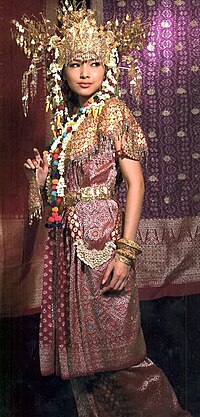Songket
From Wikipedia, the free encyclopedia
Songket is a fabric that belongs to the brocade family of textiles of Malaysia, Brunei, and Indonesia. It is hand-woven in silk or cotton, and intricately patterned with gold or silver threads. The metallic threads stand out against the background cloth to create a shimmering effect. In the weaving process the metallic threads are inserted in between the silk or cotton weft (latitudinal) threads.
Etymology[edit]
The term songket comes from the Malay/Indonesian word sungkit, which means "to hook". It has something to do with the method of songket making; to hook and pick a group of threads, and then slip the gold and silverthreads in it.[1] Some says that the word songket was derived from songka, a Palembang cap in which gold threads was first woven.[2] The word menyongket means ‘to embroider with gold or silver threads’. Songket is a luxury product traditionally worn during ceremonial occasions as sarong, shoulder cloths or head ties. Tanjak or Songket headdresses were worn at the courts of the Malay Sultanates.[3] Traditionally Muslim women and adolescent girls wove songket; "some boys and men are also weaving today".[2] Traditionally-patterned Sumatran textiles embody a system of interpretable emblems.
History[edit]
The historical records of use of gold thread in Indonesia and Malaysia is somewhat sketchy.[2] Songket weaving is historically associated with areas of Malay settlement, and the production techniques could have been introduced by Indian or Arab merchants.[2] It is not certain as to the songket's place of origin, however according to Kelantan tradition this weaving technique came from the north, somewhere in theCambodia-Siam region and expanded south into Pattani, and finally reach the Malay court of Kelantan and Terengganu as early as 1500s.[4][5] The weaving of songket continues as a small cottage industry on the outskirts of Kota Bahru and Terengganu.[6] However, Terengganu weavers believe that songket weaving technique was introduced to Malaysia from India through Sumatra's Palembang and Jambi where it probably originated during the time of Srivijaya (7th to 11th century).[2]
In Indonesian tradition, songket is associated with Srivijaya,[7][8] a wealthy 7th to 13th century maritime trading empire based on Sumatra, due to the fact that Palembang is the famous songket producer in Indonesia. Songket is a luxurious textile that required some amount of real gold leafs to be made gold threads and hand-woven into exquisite fabrics, hictorically the gold mines are located in Sumatra hinterland; Jambi and Minangkabau highlands. Although gold threads was found buried in the Srivijaya ruins in Sumatra, along with unpolished rubies and pieces of gold plate, there is no corroborating evidence that the local weavers used gold threads as early as 600s to early 700s CE.[2]Songket probably developed in later period somewhere in Sumatra.
Much documentation is sketchy about the origins of the songket but it is most likely that songket weaving was brought to Peninsular Malaysia through intermarriages between royal families. This was a common occurrence in the 15th century for sealing strategic alliances. Production was located in politically significant kingdoms because of the high cost of materials; the gold thread used was originally wound with real gold leaf.[9]
Songket as king's dress was also mentioned by Abdullah bin Abdul Kadir writings in 1849.[10]
Production centers[edit]
In Indonesia, songket is produced in Sumatra, Kalimantan, Bali, Sulawesi, Lombok and Sumbawa. In Sumatra the famous songket production centers is in Minangkabau Pandai Sikek area, West Sumatra,[11] and Palembang, South Sumatra. In Bali, songket production villages can be found in Klungkung regency, especially at Sidemen and Gelgel village. While in the neighboring island of Lombok, the Sukarara village in Jonggat district, Central Lombok regency, is famous for songket making.[12] Outside of Indonesia, further production areas include the east coast of the Malay Peninsula[13] especially in Terengganu and Kelantan, and in Brunei.[9]
References[edit]
- Summerfield, Anne; John Summerfield (1999). Walk in Splendor: Ceremonial Dress and the Minangkabau. UCLA. ISBN 0-930741-73-0.
Further reading[edit]
- Smith, Holly S. Aceh Art and Culture (Kuala Lumpur: Oxford University Press), 1997.
Notes[edit]
- ^ National Geographic Traveller Indonesia, Vol 1, No 6, 2009, Jakarta, Indonesia, page 63
- ^ a b c d e f Gold Cloths of Sumatra: Indonesia’s Songkets from Ceremony to Commodity, Cantor Art Gallery, Worcester, Massachusetts, 2007, by Susan Rodgers, Anne Summerfield, John Summerfield
- ^ "The Art of Songket"
- ^ Gold cloths of Sumatra: Indonesia's songkets from ceremony to commodity By Susan Rodgers, Anne Summerfield, John Summerfield, Cantor Art Gallery
- ^ Songket:Malaysia's woven treasure Grace Inpam Selvanayagam Oxford University Press, Mar 1, 1990
- ^ The Grove encyclopedia of Islamic art and architecture, Volume 2 By Jonathan M. Bloom, Sheila Blair
- ^ "The Ancient Sriwijaya Heritage" Featuring Glimpse of Songket in Traditional Southern Sumatra Wedding Ceremony
- ^ Sriwijaya Post. "Motif Abstrak Songket palembang" (in Indonesian). Sriwijaya Post. Retrieved 2012-01-16.
- ^ a b Uchino, Megumi (July 2005). "Socio-cultural history of Palembang Songket". Indonesia and the Malay World (Routledge) 33 (96): 205–223. doi:10.1080/13639810500283985.
- ^ Hikayat Abdullah By Hamzah Hamdani
- ^ Tenun Songket Pandai Sikek (Sumatera Barat - Indonesia)
- ^ National Geographic Traveller Indonesia, Vol 1, No 6, 2009, Jakarta, Indonesia, page 62
- ^ The Malay handloom weavers: a study of the rise and decline of traditional ... By Maznah Mohamad



Tidak ada komentar:
Posting Komentar